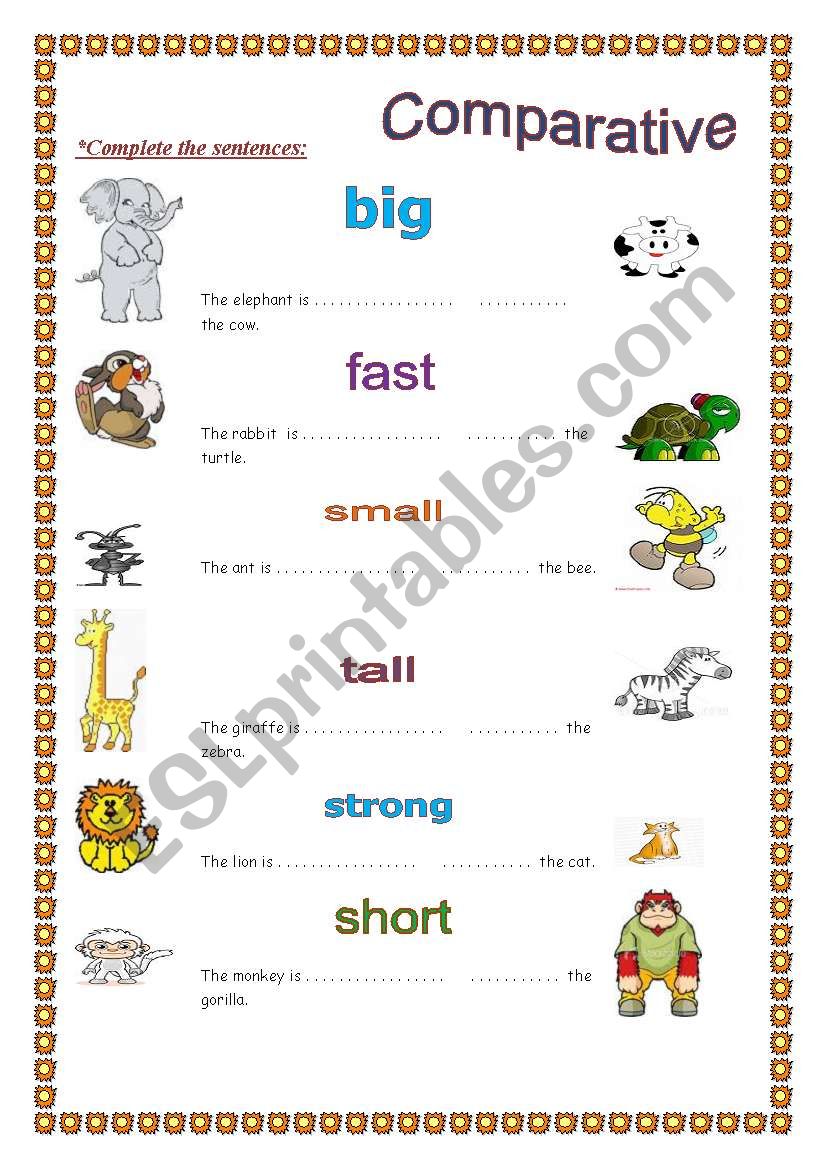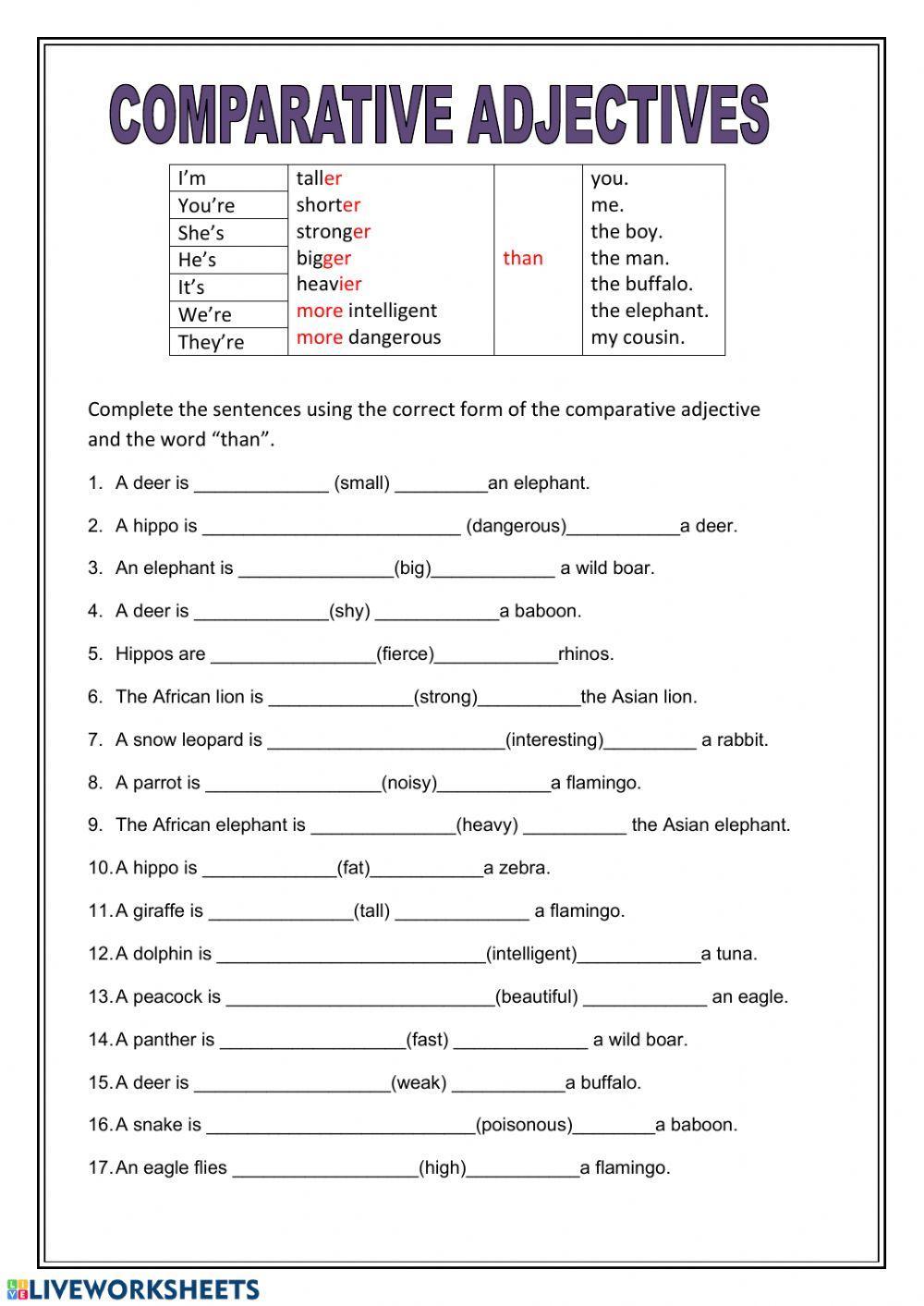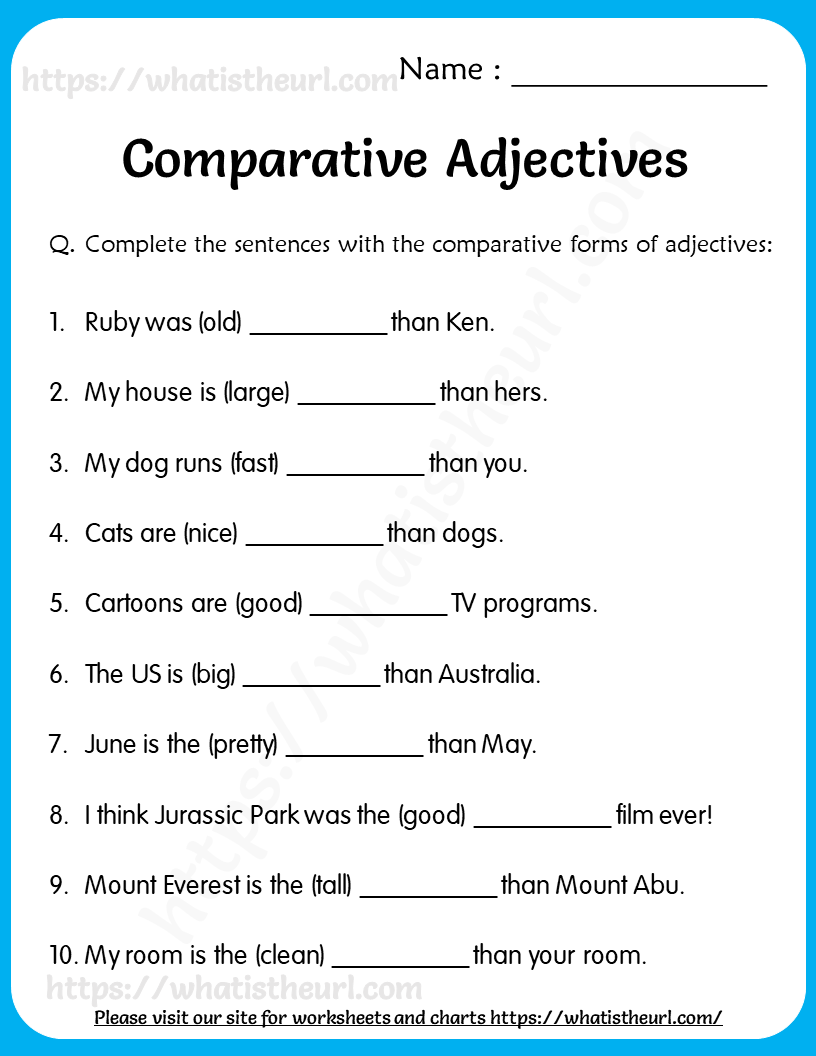
Mastering the Art of Comparison: The Indispensable Forming Comparatives Worksheet
In the vast and intricate landscape of the English language, the ability to compare and contrast is not merely a linguistic nuance but a fundamental skill that underpins effective communication. Whether describing two objects, comparing performance, or discussing preferences, comparative adjectives and adverbs are the building blocks that allow us to express relative qualities. For English language learners, mastering the rules of comparative formation can be a challenging yet rewarding journey. This is where the forming comparatives worksheet emerges as an indispensable tool, offering structured practice, clear rules, and a systematic approach to conquer this vital grammatical concept.
This comprehensive article will delve into the intricacies of comparative formation, explore the unparalleled benefits of a dedicated worksheet, and provide insights into designing and utilizing such a resource for optimal learning.
The Anatomy of Comparison: What Are Comparatives?

At its core, a comparative is a grammatical construction used to compare two people, places, things, or ideas. It highlights a difference or similarity in degree, answering questions like "Which is bigger?" or "Who is faster?" Unlike superlatives, which compare three or more things and indicate the extreme (e.g., "the biggest," "the fastest"), comparatives are exclusively for binary comparisons.

For instance, we say:

- "My car is faster than yours."
- "She is more intelligent than her brother."
- "The red apple is sweeter than the green one."


The proper formation of these comparative structures is crucial for clarity and grammatical correctness.
Mastering the Rules: How Comparatives Are Formed

The method for forming comparatives depends largely on the number of syllables in the adjective or adverb. Understanding these rules is the first step towards proficiency, and a good forming comparatives worksheet will systematically address each category.
1. One-Syllable Adjectives and Adverbs:

For most one-syllable adjectives and adverbs, we add "-er" to the end.
- Tall → Taller (e.g., John is taller than Mark.)
- Fast → Faster (e.g., A cheetah runs faster than a lion.)
- Old → Older (e.g., My sister is older than me.)
- Short → Shorter (e.g., This path is shorter than the other.)


Spelling Rules for One-Syllable Adjectives:
- Adjectives ending in a single vowel + single consonant: Double the final consonant before adding "-er."
- Big → Bigger (e.g., An elephant is bigger than a mouse.)
- Hot → Hotter (e.g., Summer days are hotter than spring days.)
- Thin → Thinner (e.g., She became much thinner after her diet.)
- Adjectives ending in -e: Simply add "-r."
- Large → Larger (e.g., My new apartment is larger than my old one.)
- Wise → Wiser (e.g., With age comes wiser decisions.)
- Brave → Braver (e.g., The soldier was braver than his comrades.)
2. Two-Syllable Adjectives Ending in "-y":
For two-syllable adjectives that end in "-y," change the "y" to "i" and then add "-er."
- Happy → Happier (e.g., She looks happier today.)
- Easy → Easier (e.g., Learning English gets easier with practice.)
- Heavy → Heavier (e.g., This box is heavier than the last one.)
- Funny → Funnier (e.g., His new jokes are funnier than his old ones.)
3. Adjectives and Adverbs with Two or More Syllables (excluding those ending in -y):
For most adjectives and adverbs with two or more syllables, we use "more" or "less" before the adjective/adverb. We do not change the form of the adjective/adverb itself.
- Beautiful → More beautiful (e.g., The sunset was more beautiful than I imagined.)
- Difficult → More difficult (e.g., This exam is more difficult than the last.)
- Expensive → More expensive (e.g., Luxury cars are more expensive than economy cars.)
- Comfortable → More comfortable (e.g., This armchair is more comfortable.)
- Quickly → More quickly (e.g., He finished the race more quickly than anyone else.)
- Carefully → More carefully (e.g., Drive more carefully in the snow.)
4. Irregular Comparatives:
A small but crucial group of adjectives and adverbs have irregular comparative forms. These do not follow any of the standard rules and must be memorized.
- Good → Better (e.g., His performance was better than expected.)
- Bad → Worse (e.g., The weather got worse as the day went on.)
- Far → Farther / Further (e.g., We walked farther/further than planned.)
- Note: "Farther" typically refers to physical distance, while "further" can refer to physical distance or abstract extent/progress.
- Little (amount) → Less (e.g., I have less money than you.)
- Much/Many (amount) → More (e.g., She has more experience than her colleague.)
The Indispensable Role of a Forming Comparatives Worksheet
Given the diverse rules and irregular forms, systematic practice is paramount. This is where a well-designed forming comparatives worksheet becomes an invaluable educational asset for both teachers and learners. It provides a structured environment to apply the rules, identify patterns, and solidify understanding.
Here’s why such a worksheet is indispensable:
- Structured Practice: Worksheets break down the complex topic into manageable exercises, allowing learners to focus on one rule or type of adjective at a time before integrating all concepts.
- Reinforcement of Rules: Repeated application of the rules helps embed them in the learner’s memory, moving beyond rote memorization to true comprehension.
- Identification of Gaps: Through completing a worksheet, learners (and their instructors) can quickly pinpoint areas of confusion or specific rules they haven’t fully grasped, such as the irregular forms or the doubling of consonants.
- Self-Assessment: Many worksheets come with answer keys, enabling learners to check their work independently, learn from their mistakes, and track their progress. This fosters autonomy and self-directed learning.
- Teacher Assessment and Differentiation: For educators, a worksheet serves as an excellent diagnostic tool to gauge student understanding and identify common errors across a group. It also allows for differentiation, where more advanced learners might tackle complex sentence transformations while others focus on basic form changes.
- Confidence Building: Successfully completing exercises on a worksheet builds confidence in a learner’s ability to handle comparative forms, encouraging them to use them actively in their speaking and writing.
Components of an Effective Forming Comparatives Worksheet
Not all worksheets are created equal. An effective forming comparatives worksheet incorporates several key elements to maximize its educational impact:
- Clear Instructions: Each section should have concise, unambiguous instructions that tell the learner exactly what to do.
- Varied Exercise Types: To cater to different learning styles and prevent monotony, a good worksheet will feature a range of exercise formats:
- Fill-in-the-Blanks: Provide sentences with blanks where the comparative form needs to be inserted (e.g., "The elephant is _____ (big) than the lion.").
- Sentence Transformation: Ask learners to rewrite sentences using comparative forms (e.g., "My house is not as large as yours." → "Your house is larger than mine.").
- Error Correction: Present sentences with incorrect comparative forms and ask learners to identify and correct them (e.g., "He is more tall than his brother." → "He is taller than his brother.").
- Multiple Choice: Offer a selection of comparative forms for learners to choose the correct one.
- Matching Exercises: Match base adjectives with their correct comparative forms.
- Open-Ended Sentences/Prompts: Encourage learners to create their own comparative sentences based on given prompts or images (e.g., "Compare two animals from the picture using comparatives.").
- Gradual Difficulty: The exercises should progress from simpler tasks (e.g., forming comparatives of one-syllable adjectives) to more complex ones (e.g., irregular forms, long sentences requiring multiple comparative applications).
- Engaging Content: Using relevant and interesting topics or scenarios in the sentences can make the learning process more enjoyable and relatable.
- Answer Key: Crucial for self-assessment, an answer key allows learners to check their work and understand where they went wrong.
- Space for Answers: Ample space for writing answers ensures neatness and ease of grading.
Designing and Utilizing a Forming Comparatives Worksheet
For Educators:
- Pre-Assessment: Use a basic worksheet at the beginning of a unit to gauge existing knowledge.
- In-Class Practice: Integrate sections of the worksheet during lessons to reinforce newly taught rules.
- Homework: Assign as homework to consolidate learning outside the classroom.
- Remedial Work: For students struggling, provide targeted worksheets focusing on their specific areas of difficulty.
- Progress Tracking: Keep completed worksheets to monitor individual student progress over time.
- Interactive Sessions: Turn the worksheet into a group activity, having students work together or compete.
For Learners:
- Independent Study: Use the worksheet as a self-study tool to review and practice at your own pace.
- Self-Testing: Treat sections of the worksheet as mini-quizzes to test your recall of rules and forms.
- Identify Weaknesses: Pay close attention to the questions you get wrong. This indicates areas where you need more practice or review.
- Review and Revisit: Don’t just do a worksheet once. Revisit it after a few days or weeks to ensure the knowledge has stuck.
Common Pitfalls and How a Worksheet Helps
Learners often encounter specific challenges when forming comparatives. A well-designed forming comparatives worksheet can effectively address these:
- Over-generalization of Rules: Applying "-er" to all adjectives, regardless of syllable count (e.g., "beautifuler"). Worksheets with varied exercises force learners to consider syllable count.
- Forgetting Irregular Forms: Using "gooder" or "badder." Dedicated sections on irregulars in the worksheet help with memorization through repetition.
- Spelling Errors: Incorrectly doubling consonants or changing "y" to "i." Exercises specifically targeting spelling rules reinforce correct formation.
- Confusion with Superlatives: Using comparative forms when a superlative is needed, or vice-versa. While this article focuses on comparatives, a comprehensive worksheet might briefly differentiate between the two to prevent confusion.
- Misuse of "Than": Omitting "than" after the comparative adjective (e.g., "He is taller I am"). Sentence completion exercises reinforce the necessity of "than."
Beyond the Worksheet: Integrating Practice for Mastery
While the forming comparatives worksheet is a cornerstone of learning, it is most effective when integrated into a broader learning strategy.
- Oral Practice: Engage in conversations where comparisons are necessary. Describe two pictures and compare them, or discuss preferences for different items.
- Real-World Application: Pay attention to comparatives in everyday English – in books, movies, news articles, and conversations. Try to identify the rules being applied.
- Games and Interactive Activities: Use online quizzes, flashcards, or group games that require the rapid formation of comparatives.
- Writing Tasks: Incorporate comparative adjectives and adverbs into essays, descriptions, or opinion pieces. For example, write a paragraph comparing two cities or two types of food.
- Contextual Learning: Learn comparative forms within sentences rather than as isolated words. This helps with understanding their natural usage.
Conclusion
The ability to form and use comparatives correctly is a hallmark of proficient English communication. It allows for nuanced expression, enabling speakers and writers to articulate differences and preferences with precision. For any English language learner striving for mastery, the forming comparatives worksheet stands out as a foundational and highly effective tool.
By offering systematic practice, reinforcing complex rules, and allowing for self-assessment, these worksheets transform a potentially daunting grammatical concept into an achievable learning goal. When combined with varied learning activities and consistent application, a dedicated forming comparatives worksheet not only builds grammatical accuracy but also fosters the confidence necessary to compare, contrast, and communicate effectively in the dynamic world of the English language. Embrace this powerful resource, and watch your comparative skills flourish.
